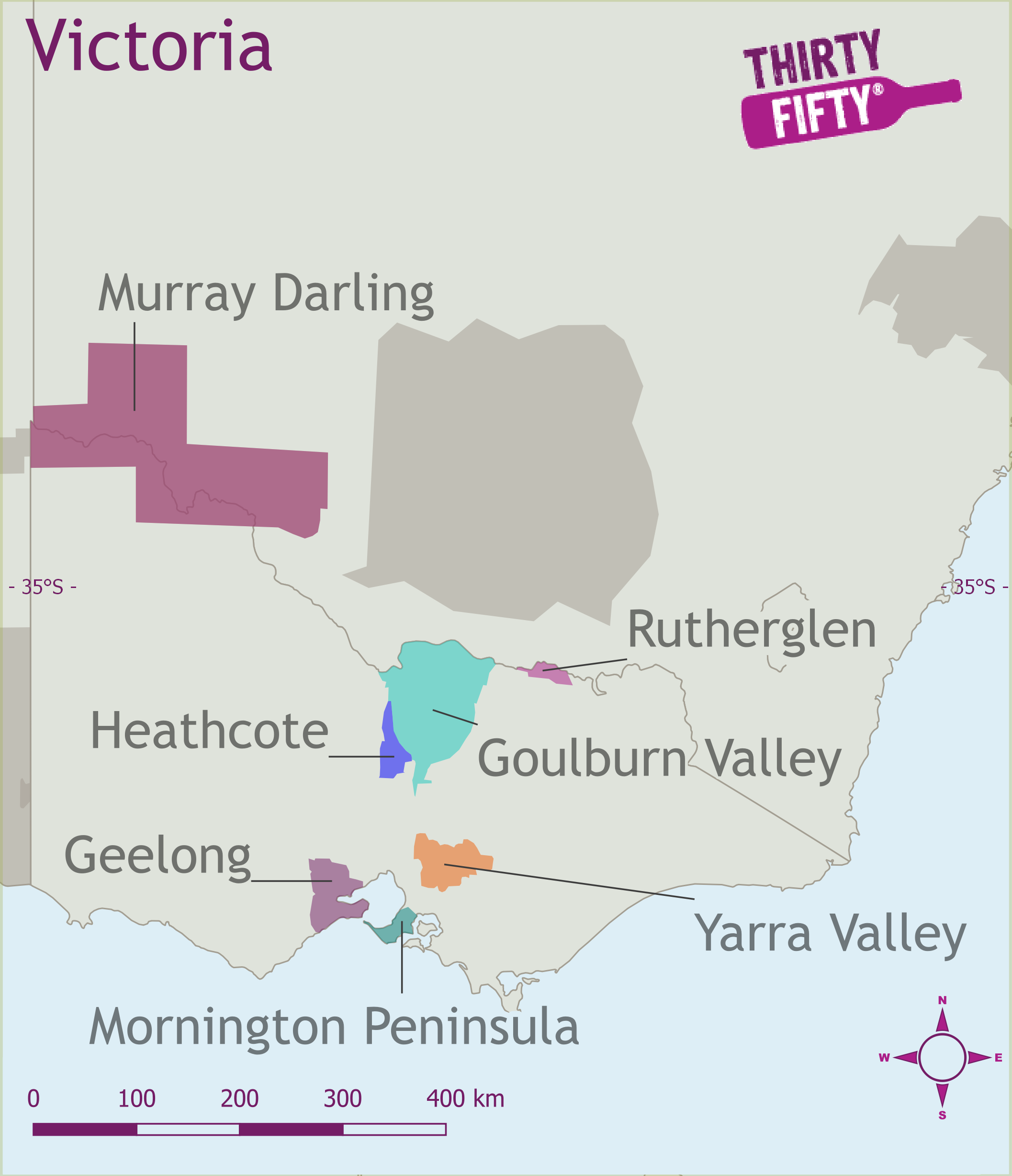Victoria's Grapes: Cabernet Sauvignon, Chardonnay, Shiraz, Pinot Noir
Cabernet Sauvignon
Cabernet Sauvignon is perhaps the most famous red grape. Its home is Bordeaux where it is was created as a cross between Cabernet Franc (red grape) and Sauvignon Blanc (white grape). Since then its popularity has spread and it is grown all around the world. It prefers warmer climates to ripen fully and even in Bordeaux some years it does not ripen. That is why Cabernet Franc is also used in Bordeaux blends as it ripens faster. What makes Cabernet so popular is not its bouquet, which can range from blackcurrants to cigar box, but its structure, typically having both tannins and acidity to create a smooth feeling in the mouth. The structure allows the blending with other grapes, perhaps the most famous pairing is Cabernet Sauvignon and Merlot where the Cabernet provides the structure and the Merlot gives the wine the soft, rounded feel in the mouth. Recently Cabernet has been mixed with Sangiovese (Chianti's grape) to create the SuperTuscans.
Chardonnay
Jancis Robinson described Chardonnay as the tart of the grape world, as it would lie down anywhere and do what the winemaker told it to do! In other words it will grow almost anywhere and produce decent and quite stylistically different wines ranging from minerally Chablis, Champagne, buttery fruit wines, tropical fruit wines or oaky vanilla wines. During the late 1990's Chardonnay was the drink of choice for many. However people became bored with the oaky wines found in so many bars and the term, 'ABC' (Anything but Chardonnay) came about. The ubiquitous yet noble Chardonnay grape has virtually become a brand name. From its homeland in Burgundy, its fame and fortune have taken it all over the world. It�s grown on different soils in varying climates to be used either as a single varietal or in blends, for still and sparkling wines, and with or without oak ageing to create a wide range of wines with diverse personalities. As a result, it�s impossible to describe a typical Chardonnay. For a start, the grape can make anything from an everyday glugger to a high-quality wine deserved of ageing. Its popularity in the vineyard stems from the fact that it�s easy to grow, consistently yielding generously with relatively high sugars (and, therefore, alcohol). In the winery its advantages are obvious � it�s difficult to make a poor wine from it, unless it�s been picked too late, because then its acid levels fall quickly, which make it flabby. Chardonnay isn�t strongly aromatic: some detect anything from apples (or barely ripe apples in Chablis) and melon in Maconnais Chardonnay to tropical fruit flavours in New World examples. Common descriptives, however, tend to refer to texture and weight rather than flavour � buttery for broader styles, such as Meursault from the Cote de Beaune; steely for Montrachets and nutty for Corton-Charlemagne. There�s an attractive leanness to fine Cote d�Or white burgundy, that sets it apart from Chardonnays from the rest of the world, but this can be emulated further south in the Cote Chalonnaise and Maconnais in good vintages with clever winemaking.
Shiraz
Shiraz and Syrah are the same grape. However apart from Australia where it is always called Shiraz, and France where it is Syrah, the rest of the world tends to follow the style of these two. If the wine is ripe and full bodied the wine is often called Shiraz. If the wine has less fruit, more acidity and lower alcohol, it tends to be called Syrah after the wines produced into the North of Rhone. Shiraz/Syrah is produced by itself or can be blended typically in three ways. A small amount of the white grape Viognier can lift the deep flavours of Syrah, this is common in Northern Rhone. In Southern Rhone and recently Australia, blending has been based around adding Grenache and Mourvedre, copying the blending behind Chateauneuf-du-Pape. Even more recently Cabernet Sauvignon and Shiraz/Syrah has been blended in the Southern French wine region of Languedoc, creating big wines with elegance. Hotter climate Shiraz often has aromas of plum, tar and leather and with the right oak treatment even chocolate. Cooler climate Syrah can have a peppery note to the wine.
Pinot Noir
Pinot Noir (pronounced PEA-no NWAHR, the grape that produces Burgundy's finest red wines, is one of the hardest to grow. This thin-skinned variety is generally an early budder and ripener, so it is best-suited to cool, marginal climates - 40 to 50 degrees latitude - and only produces good wine when the fruit is controlled to very low yields. It has the problem that it mutates easily and is also particularly susceptible to leaf roll, and to rot because of its compact grape bunches. Pinot has no single recognisable flavour or style. Young Burgundy, however, can be reminiscent of raspberries or strawberries, while mature French Pinot tends to evolve into anything from violets, game and truffle to farmyard aromas and compost. Despite its difficult temperament, Pinot Noir is hardly just a French phenomenon. It crops up in Northern Italy, Germany, Switzerland and Eastern Europe as well as California, Australia, New Zealand and even South Africa and Chile. It�s a successful ingredient for sparkling wine and is one of three grapes used in champagne, bringing good acidity, structure and body. Pinot Noir goes by a long list of names, which include Spatburgunder and Blauburgunder in Germany and Klevner in Switzerland.
Wine Regions for Victoria
- Geelong
- Goulburn Valley
- Heathcote
- Mornington Peninsula
- Yarra Valley
Victoria
Key Grape Varieties: Cabernet Sauvignon, Chardonnay, Shiraz, Pinot Noir

Victoria is Australia's coolest wine region, Although 80% of grapes by volume are grown in the warmer Murray Darling region which straddles both Victoria and New South Wales along with Swan Hill.


